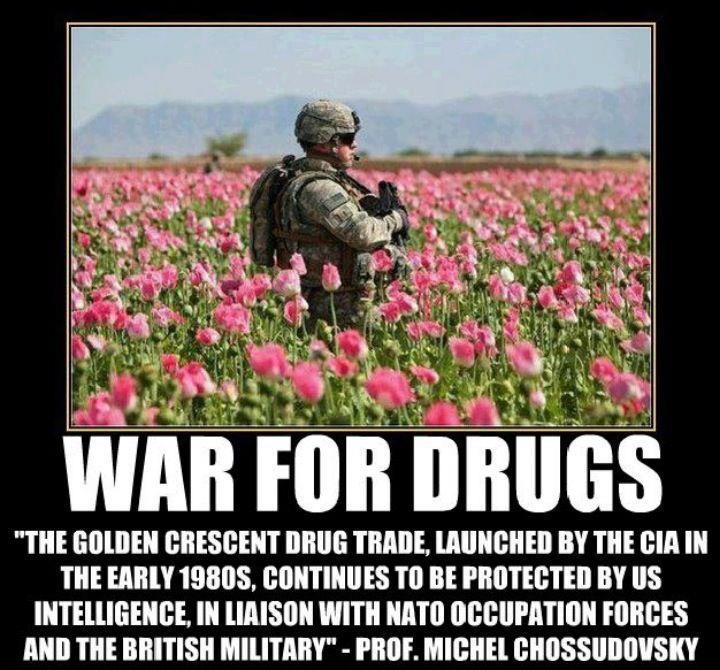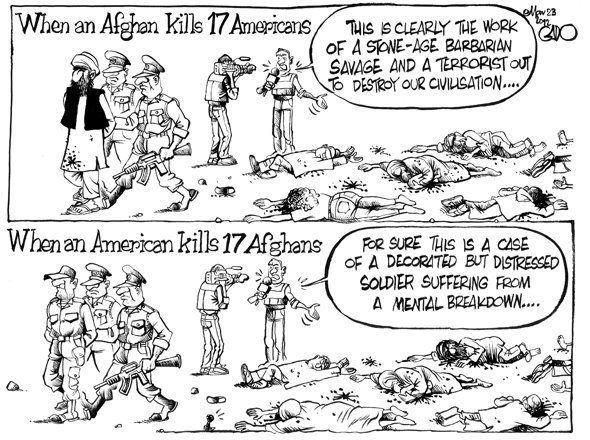|
|
|


Afghanistan America's source for Heroin
When anybody talks about G.W. Bush's Fiascos, they talk about cocaine use, stolen elections, and Iraqi War, but what about Afghanistan? We are spending just as much money there as Iraq and to many, failures there are even higher.
When the press refers to Afghanistan's history it is to the Soviet invasion of the 1980s or the earlier great game that ended with the British Empire's departure from South Asia in 1947. There is a silence about the three decades in between. During that time, Afghanistan was divided between the Soviet Union in the north and the United States in the south.
So what happened in those 30 some years and does it reflect on the Afghanistan of today?
In the 1950s and 1960s, the United States made southern Afghanistan a showcase of nation building with a dazzling project to "reclaim" and modernize a swath of territory comprising roughly half the country. The Helmand Valley venture is worth remembering today as a precedent for renewed efforts to rebuild Afghanistan.The Helmand Valley is located in the southwestern portion of Afghanistan and occupies about one-fourth of the total area of the country. Average yearly rainfall in the valley area is about four inches. The valley is in the temperate zone with an elevation varying between 1,500 and 3000 feet. Humidity is low, and strong dry winds frequently blow in the westerly portion of the valley during July and August. The Helmand river is the longest in Afghanistan supplying forty percent of the country's total water resources. The obstacle towards the agricultural development of the Helmand Valley has traditionally not been a shortage of water, but a lack of adequate control of the water in the valley.
The Afghans themselves started the first development work in the area in 1910 when part of the vast work of old irrigation canals were reconstructed. They also constructed the first new functional canals by 1914. Foreign technical assistance first arrived in the 1930s when new canals were built with German and Japanese assistance. The Germans gave some technical assistance and the Japanese (1937-1941) helped dig nine miles of canals at Boghra, which was pushed ahead by another 16 miles (1941-1946) by Afghans themselves. During World War II, because of the British-Soviets ultimatum on the Afghan government to expel all Germans, Italian and Japanese personnel, the Helmand project was brought to a halt.
In 1945 negotiations began between the Afghan government and an American company, the Morrison-Knudsen on the construction of two diversion dams, one on the Helmand River and the other on its chief tributary, the Arghandab River, enlargement of an irrigation canals and the construction of roads in the Valley. An agreement was reached in 1946 resulting in the formation of Morrison-Knudsen Afghanistan Inc.. The MKA Helmand Valley Project (also called the HVP Project) has been an important turn of event in the history of modern Afghanistan. It was the largest and most ambitious project ever undertaken in the history of modern Afghanistan.
Objectives of the HVP Project included: provision of farms for nomads and land-less villagers; raising the standard of living of peoples in the valley; producing agricultural and manufactured products for export; developing electric power; creating government income which will eventually pay off the investment; providing protection against floods; and providing utilization of the waters of the Helmand River. After a preliminary survey MKA made several estimates: an initial $10.7 million would be needed for all surveys and roads necessary to begin the construction of two dams and an extensive canal system; the total cost would be $63.7 million. The canal system would include intakes, waterways, laterals and sub-laterals. However, "neither the Afghan government nor the American engineering company understood the monumental problems of enfolding an entire region in the embrace of a single project". By 1949 costs had skyrocketed first because under the agreement all equipment had to be shipped from the U.S., half way around the world from the site of the project. In 1949 Afghanistan asked the Export-Import Bank (EIB) in Washington D.C. for a $55 million loan. After an initial refusal, the EIB finally approved a $21 million loan. This marked the beginning of the US aid to Afghanistan through which the American government established its stake in the country.
By 1969, the new grains had spread to a modest 300,000 acres, half of which had been producing prior to the project. The 1971 drought destroyed much of the crops. The Arghandab reservoir dried up completely, a possibility not foreseen by planners. The vision of prosperous, irrigation-fed farms proved beyond HAVA's grasp. Wheat yields were among the lowest in the world, four bushels an acre (Iowa farms produced 180) farm incomes in the valley were below average for Afghanistan and declining. Nobody had ever tested the arid alkaline soils of the area to see if they could indeed produce crops. State Department officials found it difficult to measure the magnitude of the economic crisis. "The food crisis, seems to have been the real clincher for which neither the King nor his government were prepared." In July 1973, military units loyal to Mohammed Daoud deposed the king, who was vacationing in Europe, and terminated both the monarchy and the constitution. U.S. involvement in HAVA was scheduled to end in July 1974, and US AID officials strenuously opposed suggestions that it be renewed. Nonetheless, when Henry Kissinger visited Kabul in February, Daoud described the Helmand Valley as an "unfinished symphony" and urged the United States not to abandon it. In the end the project was a failure, of the 539,834 acres of land that was aimed to be irrigated as a result of the project only 170,000 (about 31%) acres actually received adequate water and most of these were already being farmed. Of the several ambitious objectives, only the control of floods seemed to have been achieved. There, therefore, is little doubt that the HV project represented a miscalculation on the part of all those involved. This despite the warning from numerous sources that the project was doomed to the fate it eventually encountered.
Without a strong central government the area returned to tribal rule. The Helmand Valley provided the new regime's chief source of revenue, the opium poppy. The opium poppy grows well in dry climates and in alkaline and saline soils. Late seventies brought record crops of poppies. After the Soviet invasion of 1980 Poppy controls were put in place and production dropped greatly, but due to soil composition, no replacement crops ever took hold. So the USA stepped in arming and training the tribes to drive the soviets back. With the tribes worked together in the 1990's the Taliban developed, and they were anti-drugs so poppies once more were illegalized and crops destroyed.
Before that order, Afghanistan had been the world's largest producer of opium poppies. As a result of the ban, areas of Afghanistan controlled by the Taliban produced a few hundred tons of opium, compared with 3,200 tons produced last year and 4,500 tons the year before. During its five years in power, the Taliban government invested in the dams and finished one project begun but not completed by the Americans. The Kajakai Dam's hydroelectric plant to the city of Kandahar was finished in early 2001, just a few months before American bombers destroyed the plant. A year after a Taliban ban virtually wiped out opium production in Afghanistan, desperate Afghan farmers are once again planting poppies, poppies and their final product heroin returned on a grand scale. Afghanistan once is the world largest producer of opium and heroin.So does anyone else see the pattern here? Every time the US helps Afghanistan poppy production rises, even now while Afghanistan is basically occupied and controlled by US forces, America's need for Heroin is being satisfied by the poor peasants of Afghanistan. In 2007 Afghanistan produced 200% of the world's need for heroin, now the farmers are starting to plant marijuana, which means the same people selling heroin will soon be selling pot as well. How does the current administration explain this? How can they? So who in Washington is getting rich off this and why are we in Afghanistan anyway?
Update march 2014

random links transporting dazed and confused free range arachnids to insane asylums since 1995
woodstock nation back to the garden mission impossible Subway Chronic God Money
clinton square as a box turtle star trek ventura USA Rainbow farms extra meat
time Don't suspend disbelief Don't arrest it curtail it unfrock risks chess monopoly scrabble captured killed
under constitutional convention economy farm aid tents rent can't buy my ego
drug war Ottoman Obama Empire protection legalization admits smoking